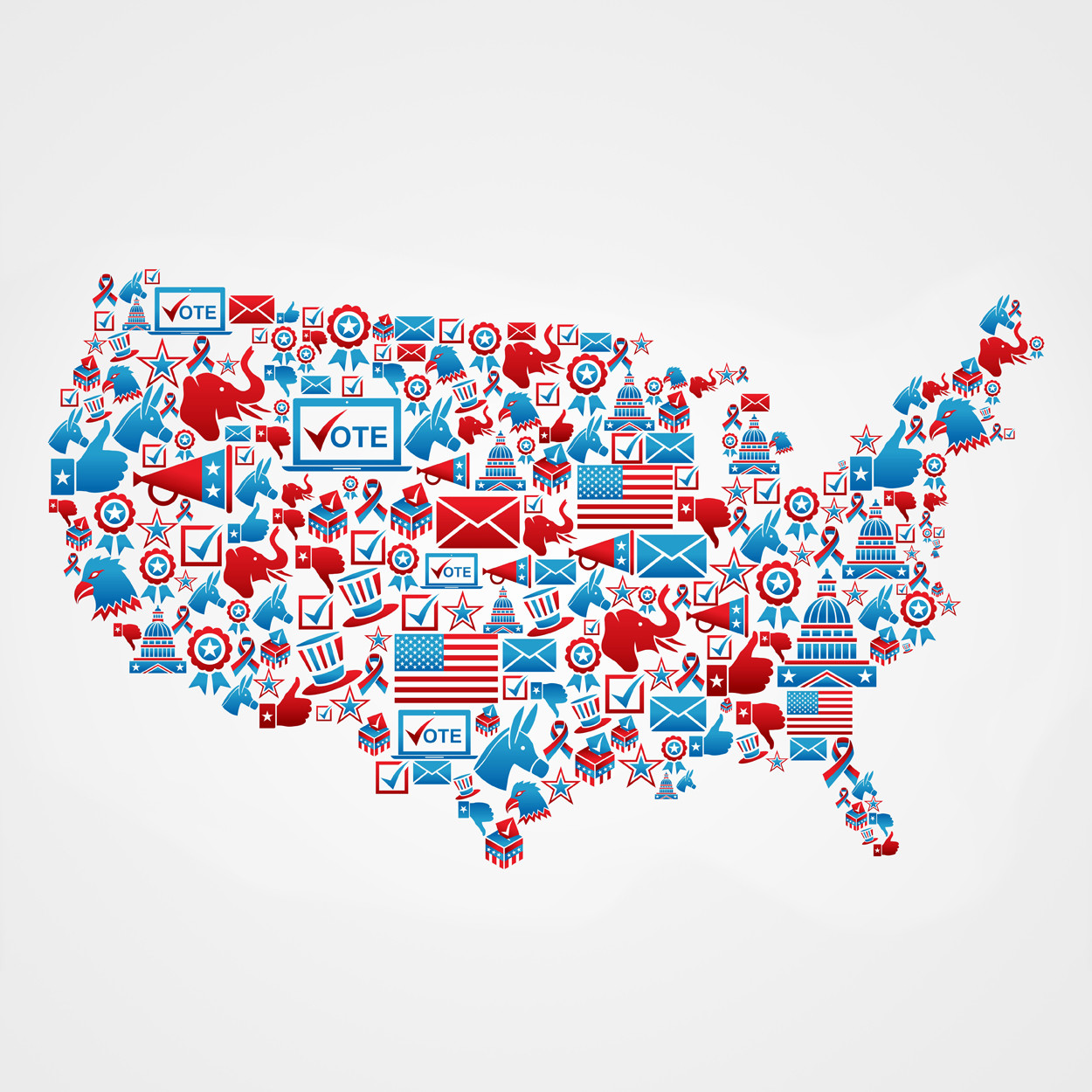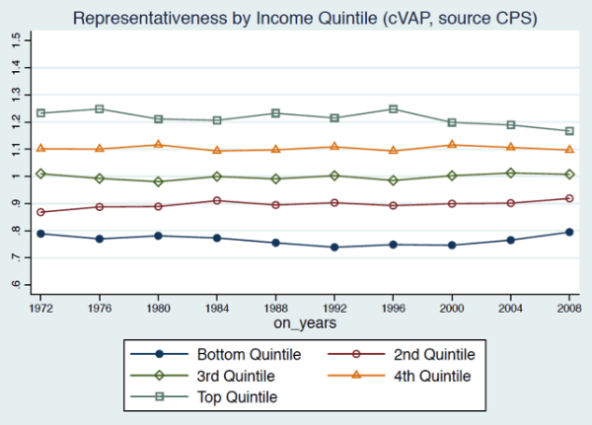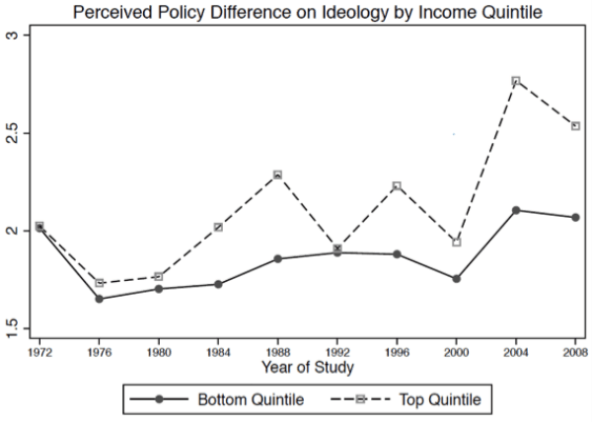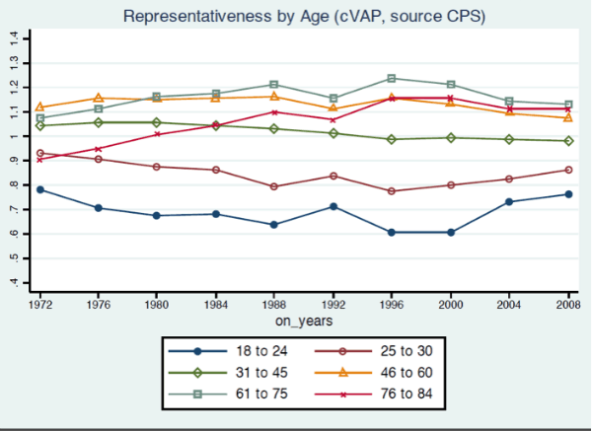Elections are essentially about making choices. Individual citizens choose who will best represent their interests in elected office; they also choose whether or not to cast a ballot. But what if citizens do not have enough information to know who would best represent them?
Scholars typically agree that understanding what people know (or don’t know) about political parties and candidates and the electoral process is important to understanding voter turnout. Individuals with higher levels of education, for example, are more likely to vote than individuals with less education, in part due to higher levels of information about how and where to vote, how elections work, and the candidates and issues in the election at hand. Studies of get-out-the-vote efforts typically confirm that contacting individuals about an election—and providing different types of information about it—are effective at increasing voter turnout.

Higher levels of turnout in presidential elections compared to elections in other years are also assumed to be, at least in part, a function of the difference in the information environments of these elections. Elaine Kamarck of the Brookings Institution discusses this issue later in this series. Presidential elections, for example, witness higher levels of news coverage, paid political advertising, and other campaign mobilization efforts—and higher levels of turnout—than off-year elections.
Each of these campaign features provides information that can decrease the “costs” of voting for individuals, where costs represent the time and effort it takes a person to learn enough about the election to be able to vote. Scholars talk about the costs of voting as part of the “calculus of voting,” which poses the turnout decision as a reflection of costs and benefits. The assumption is that people vote when benefits are greater than costs. Usually the benefits to the voter are the improvements they would realize in their lives if the policy positions of a certain candidate were enacted.
But little attention has been paid to the idea that information about the benefits of voting can also increase turnout. Yet if an individual believes both candidates will enact the same policies, then she does not expect a policy benefit for electing one candidate over the other—and she is less likely to vote. Only if it is clear that there is a difference in benefits to the voter based on the candidates’ distinct policy positions will the voter have (a policy-based) incentive to vote.
In our book Who Votes Now? (Princeton University Press, 2013), we offer new evidence that in presidential elections from 1972 to 2008, individuals who perceived a difference between the policy positions and ideological positions of the Republican and Democratic presidential candidates were more likely to vote than those who were not aware of these differences. According to our estimates, a potential voter who perceived that the candidates’ political ideologies and positions on the government role in guaranteeing jobs were one standard deviation apart on a 7 point scale were about 10 percentage points more likely to vote than a potential voter who could not see any differences between the candidates.
We also provide evidence in Who Votes Now? that there is a remarkable level of stability in the class bias of the electorate, i.e., the over-representation of the wealthy as voters, compared to their size in the eligible electorate.
[NOTE: The figures below use a representativeness index to compare each group’s share of the voters to the group’s share of citizens among the voting age population (i.e., the eligible electorate). Values greater than 1 indicate that the group has a greater share of the voters than it does of the population, and is thus over-represented among the voters. So in the figure below, the top quintile's representativeness ratio of 1.2 means that that top quintile's share of the voters is 20 percent higher than its share of the set of the citizen-voting age population. As the figure shows, the top two income groups are over-represented, and the bottom two income groups are under-represented.]
 (Source: Figure 2.8, Who Votes Now?)
(Source: Figure 2.8, Who Votes Now?)
When we were researching our book, we were somewhat surprised by this pattern of stability over a period of increasing economic inequality in the United States. So we investigated informational differences between the wealthy and the poor. What we found is that individuals with less income are less likely to be aware of policy and ideological differences between the presidential candidates. As the figures below show, people in the lowest income group were substantially less likely to be aware that there are significant differences in ideology between Democratic and Republican presidential candidates, and also less likely to be aware that the candidates differed in their policy views on major issues.
 (Source: Figure 5.9, Who Votes Now?)
(Source: Figure 5.9, Who Votes Now?)
 (Source: Figure 5.10, Who Votes Now?)
(Source: Figure 5.10, Who Votes Now?)
For instance, in 2008 people in the bottom income quintile perceived the Republican and Democratic candidates to be about 2 points apart on ideology (measured on a 7 point scale), while people in the top income quintile perceived the Republican and Democratic candidates to be 2.5 points apart on ideology.
Although candidates do provide a certain amount of policy information in the course of their campaigns (as Thad Kousser and Seth Hill of the University of California, San Diego note in their article in this series), they devote most of their efforts to registered and (especially) “likely” voters and ignore those who are believed to be unlikely voters. That means that non-voters, and especially non-voters from groups of people who are least likely to vote (those with lower levels of income and education, as well as Latinos and youth) are the least likely to be exposed to outreach efforts. The two figures below show representation by age and by ethnicity, respectively, showing the low levels of representation among young people (especially ages 18 to 24) and Hispanics.
 (Source: Figure A.2.2.5, Who Votes Now?)
(Source: Figure A.2.2.5, Who Votes Now?)
 (Source: Figure A2.2.3, Who Votes Now?)
(Source: Figure A2.2.3, Who Votes Now?)
We believe that providing information about candidates’ and parties’ issue positions and ideological leanings would be valuable in efforts devoted to mobilizing individuals to vote. At a time when political institutions are viewed so negatively, and the dominant rhetoric and narratives about politics are critical, all citizens need positive reasons to vote. Citizens in under-represented groups, especially, need the type of information that explains what various candidates represent, and how casting a ballot in a favor of a candidate who best represents them can make a difference in their lives. Providing that type of information to citizens who are otherwise overlooked by dominant campaign organizations could be an effective means to increase voter turnout and also strengthen the electoral process in general. Ultimately, while states can and do enact policies that increase the “costs” of voting, it is the candidates, parties, and voter outreach groups that must convince voters that the benefits of making the effort to vote are greater than the costs.
Support SSIR’s coverage of cross-sector solutions to global challenges.
Help us further the reach of innovative ideas. Donate today.
Read more stories by Jan Leighley & Jonathan Nagler.

